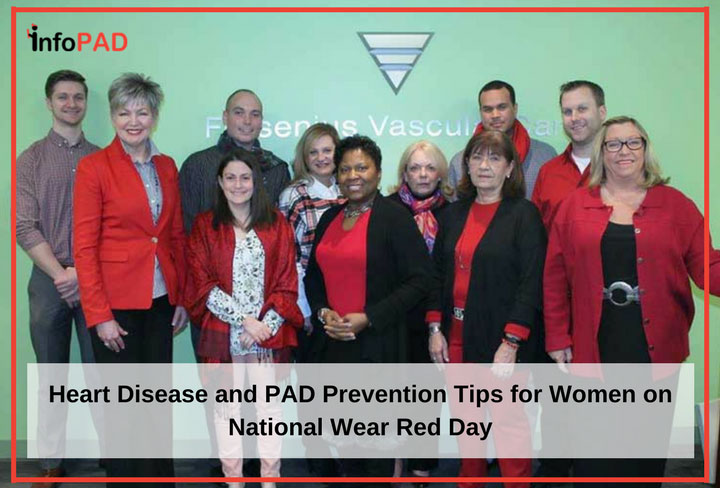
This Friday, February 5, is National Wear Red Day; the day when the American Heart Association asks the public to pay special attention to heart disease in women. Everyone, not just women, are encouraged to wear red, learn their cardiovascular risks and take action! Action can come in the form of educating your coworkers, friends or family, making a healthy lifestyle change, or even speaking with a healthcare professional about risk factors, prevention, and other conditions that raise the risk for heart disease.
Heart Disease Is the #1 Killer of Women, but It Is Preventable
Heart disease claims more women’s lives than all cancers combined. 1 in 3 deaths among women each year is a result of heart disease and stroke, yet 80% of these deaths are preventable.[1] Understanding the risk factors for women developing heart disease can help prevent heart disease or lower the mortality rate. This is especially important because 90% of women have one or more risk factors for developing heart disease.[1]
Risk Factors for Heart Disease in Women Include:[1]
- Chronic Conditions: Diabetes, High Blood Pressure, High Cholesterol
- Lifestyle Choices: Obesity, Smoking, Physical Inactivity, Poor Diet
- Atherosclerosis (hardening of the arteries)
- Age
- Family History
- Pre-Existing Heart Condition
Age, family history and pre-existing conditions are not things you can change; however, studies show that you can lower your risk by as much as 80% by making simple changes to your diet and lifestyle, such as:
- Being physically active for at least 30 minutes daily
- Drinking more water
- Baking or grilling instead of frying foods
- Avoiding foods high in sugar, saturated fats, trans fat and calories
All of these activities will make you feel physically and mentally better, and also help lower your risk for, or control your diabetes, high blood pressure, or high cholesterol. All of these can also lead to another major risk factor for heart disease, atherosclerosis.
What is Atherosclerosis and Why Does it Matter?[2]
You have probably heard the terms diabetes, high cholesterol and high blood pressure. Atherosclerosis, however, may be a new term. Atherosclerosis refers to the hardening of the arteries, and is when fatty deposits or plaque build up in the inner lining of the artery. Atherosclerosis is a disease that starts in childhood and progresses as people grow older, but typically does not present as an issue until people have reached their 50s and 60s.
Without treatment, the plaque continues to build up creating a blockage or narrowing of the artery. Eventually the plaque ruptures, forms a blood clot and will either break off and travel to another area of the body, or the blood flow will be blocked. In instances where a clot blocks a blood vessel that supplies the heart, it will cause a heart attack, in instances where the vessel supplies the brain, it causes a stroke. Early intervention and treatment are essential to prevent heart attack and stroke.
Atherosclerosis of the Limbs-Peripheral Arterial Disease (PAD)
If the plaque blocks or narrows an artery supplying blood to the arms or legs this is called Peripheral Arterial Disease. In early stages this causes leg pain and difficulty walking. As it advances, PAD can cause Critical Limb Ischemia (CLI), a severe obstruction of the arteries that drastically reduces blood flow to the limbs. Without treatment, PAD patients with CLI can experience gangrene, non-healing sores/ulcers, and face major limb amputation.[3] Early intervention and treatment are essential to prevent CLI and stop PAD from progressing beyond the limbs to heart disease or stroke. [3]
Treatment Options for PAD:
- Lifestyle changes
- Medication
- Surgery
- Non-Surgical treatments such as angioplasty, atherectomy, and stenting are minimally invasive methods to remove plaque or open the artery to increase blood flow.
If you or a family member is told you have PAD it is important to seek the proper medical care as soon as possible. Treatment for PAD is extremely effective when started early and can drastically reduce your risk for heart attack or stroke.
This Friday, February 5, remember to wear red and take action to save lives!
Sources:
[1] http://circ.ahajournals.org/content/early/2015/12/16/CIR.0000000000000350
[2] https://www.goredforwomen.org/about-heart-disease/facts_about_heart_disease_in_women-sub-category/atherosclerosis-stroke/
[3] https://www.nhlbi.nih.gov/health/educational/pad/docs/pad_extfctsht_general_508.pdf


